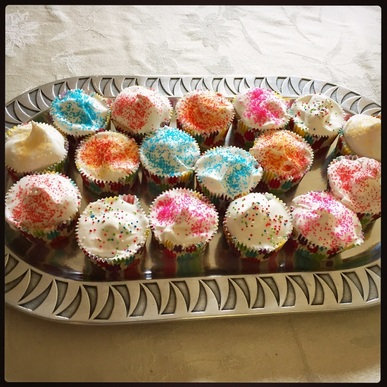It's Ice Cream Day!
Sunday, July 19, 2015 | By: Becky Diamond
Parkinson's Restaurant - Chestnut Street, Philadelphia, 1853 (Courtesy Library of Congress)
"Properly prepared and served, ice creams not only enrich and adorn the table of hospitality, but they largely contribute to the health and comfort of the customer"
~ James Parkinson, Confectioners' Journal, May 1879
I couldn't agree more! James Parkinson sure knew what he was talking about. In his day, the nineteenth century Philadelphia confectioner and restauranteur was well-known for his rich, delectable ice cream creations. What better way to recognize this ice cream master than by celebrating National Ice Cream Day today - the third Sunday in July since President Reagan declared it so in 1984.
“Philadelphia ice cream” was traditionally uncooked, made with just fresh cream, fruit juice, or pulp, sugar or sugared syrup, and flavoring such as vanilla beans, thoroughly blended for a smooth consistency and rich flavor. It’s difficult to imagine that this famously decadent treat could be improved on, but Parkinson introduced and/or invented several of his own signature flavors, including pistachio, Parkinson’s original ice cream punch, and Brahma’s ice (a creamy frozen treat based on an authentic recipe from India, made with egg whites, curaçao, and orange-flower water). He featured some of these icy delicacies on the menu for his famous Thousand Dollar Dinner in 1851, including caramel ice cream, Champagne frappe à la glacé (a frothy ice made with the French sparkling wine) and biscuit glacé (a rich custardy dessert made with sponge cake and vanilla liquor).
An 1840 Philadelphia Inquirer article referred to Parkinson's biscuit glacé as a “nectarous composition" … "one of the happy thoughts which never flit across the brain of any but a genius." The “biscuit” was sponge cake that had been dried in the oven and pounded into a rich powder. It was then added to a heated and thickened mixture of cream, sugar, eggs, vanilla sugar, and vanilla liquor during the final freezing stage, before the ice cream was fully hardened.
Here's the recipe:
1 1/2 pint of cream, 12 oz. of sugar, 8 yolks of eggs, a tablespoon of vanilla sugar 6 sponge cakes dried in the oven, slow heat, and bruised, and a wineglass of vanilla liquor. Mix the sugar, eggs, vanilla sugar, and milk, previously boiled, stir the composition on the fire to thicken it, and strain it into a basin; add the liquor, freeze the ice, incorporate the biscuit powder, and then set up the ice in its mould.
In the mid-nineteenth century, ice cream and other frozen treats were getting more reasonably priced, but they were still a special extravagance mostly reserved for the wealthy due to the time and labor involved as well as the cost of the ingredients, particularly the ice delivery. They were most often served in special pleasure gardens or ice cream parlors, such as the restaurant, café, and confectionery Parkinson launched on the northwest corner of Philadelphia's Tenth and Chestnut streets in 1852. The imposing three-story brick mansion had been built in 1819 by a wealthy philanthropist named Frederick Kohn. The main entrance featured white marble steps and a large curved window above the doorway, topped by a marquee displaying the Parkinson name in large block letters. Trim grassy areas bordered either side of the door, kept tidy behind an intricate wrought-iron fence.
The adjoining ice cream saloon and confectionery store had its own equally grand entrance, with a separate sign, elaborately carved masonry, and Grecian-style stone columns. Behind the restaurant was a lush garden area featuring exotic plants, blooming trees, shrubbery and flowers, paved walkways, gas lampposts and a magnificent fountain in the center. Tucked in a corner was a large building designated as a gentlemen’s smoking and reading room, stocked with the most current books, journals, magazines, and newspapers of the day. The gardens were illuminated every evening, enticing dozens of Philadelphians on hot summer nights to the cool, refreshing spot in order to escape the heat and view the light show. Parkinson’s also featured other live entertainments such as music, fireworks, and balloon launches, all free of charge. Not a bad way to enjoy one of his sweet, creamy confections! When I take my family to our local ice cream place tonight (The Yardley Ice House) - I will fondly think of James Parkinson and his delicious contributions to the world of ice cream.
Sources: Parkinson, J.W. “Food in Ices,” Confectioners’ Journal, May 1879; “Parkinson,” Confectioners’ Journal, June 1875; Parkinson, James, American Dishes at the Centennial; “Parkinson’s Restaurant,” Gleason’s Pictorial Drawing-Room Companion, May 28, 1853; “Touches of Old Philadelphia,” Philadelphia Record, Oct. 5, 1909.






Leave a comment
0 Comments